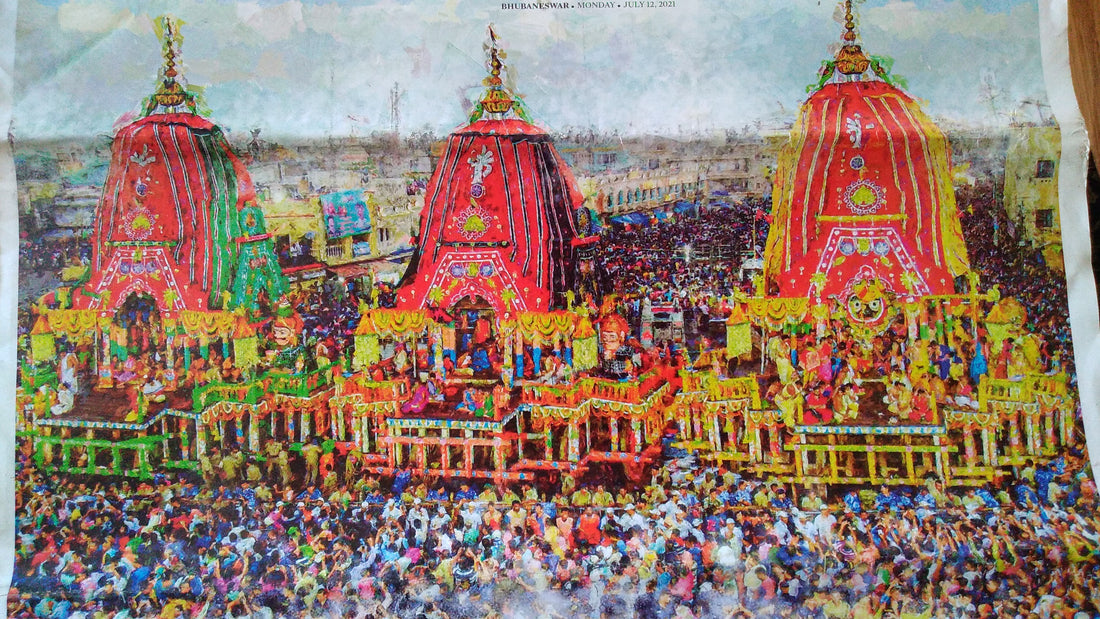
TEXTILES FOR THE LORD OF THE UNIVERSE
Surendra Kumar Patra hails from a family of ikat weavers in Nuapatna village, Cuttack district, Odisha state, India. He has deep knowledge of traditional ikat textiles of Odisha and the technicalities of ikat dyeing and weaving. He received the National Award in 1993 for Art Textile (Tie & Dye). He retired as Deputy Director, Weavers Service Centre, Ministry of Textiles, Government of India, based in Bhubaneswar, Odisha. In a follow-up to his interview on Nuapatna Weaves featured on Selvedge blog he speaks of the traditional attire of hand-woven fabrics of Lord Jagannath and the deities enshrined at the Lord Jagannath Temple at Puri, Odisha, India.
Please could tell us about Lord Jagannath
The Indian state of Odisha has an ancient culture manifest in different aspects of its rich and diverse living heritage. Odia culture is deeply influenced by Jagannath consciousness that has evolved from the worship of the Hindu deity Lord Jagannath. Jagannath culture is synonymous with Odia culture.
The word Jagannath derives from the words `Jagat’ meaning universe and `nath’ meaning lord. Lord Jagannath is respected as the Lord of the Universe and is also regarded as the representation of Lord Vishnu who has many avatars. Lord Jagannath is regarded as a form of Lord Vishnu’s avatar as God Krishna.
God Vishnu’s representation as Lord Jagannath is unique to the state of Odisha. His form is also unique as it is cylindrical rather than figural with very large eyes, and crafted of wood rather than metal or stone as most temple icons are.

Image: Baralagi Pata for Wednesday. Textile with green field and Kumbakalasi border that is a design of a temple with kalasi (an earthen pot). Image: View of Ratha Yatra, three chariots are in front of Lord Jagannath.
Please could tell us about Lord Jagannath
The Indian state of Odisha has an ancient culture manifest in different aspects of its rich and diverse living heritage. Odia culture is deeply influenced by Jagannath consciousness that has evolved from the worship of the Hindu deity Lord Jagannath. Jagannath culture is synonymous with Odia culture.
The word Jagannath derives from the words `Jagat’ meaning universe and `nath’ meaning lord. Lord Jagannath is respected as the Lord of the Universe and is also regarded as the representation of Lord Vishnu who has many avatars. Lord Jagannath is regarded as a form of Lord Vishnu’s avatar as God Krishna.
God Vishnu’s representation as Lord Jagannath is unique to the state of Odisha. His form is also unique as it is cylindrical rather than figural with very large eyes, and crafted of wood rather than metal or stone as most temple icons are.

Image: Baralagi Pata for Wednesday. Textile with green field and Kumbakalasi border that is a design of a temple with kalasi (an earthen pot). Image: View of Ratha Yatra, three chariots are in front of Lord Jagannath.
Want to read more of this article?
We are proud to be a subscriber-funded publication with members in 185 countries. We know our readership is passionate about textiles, so we invite you to help us preserve and promote the stories, memories, and histories that fabric holds. Your support allows us to publish our magazine, and also ‘what's on’ information, and subscription interviews, reviews, and long-read articles in our online blog.
ALREADY A SUBSCRIBER? CLICK HERE TO ACCESS CONTENT

